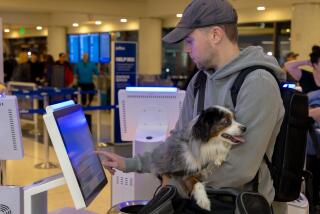Reducing Night Flights May Ease Winter Global Warming, Report Says
Contrails from winter night flights may be most responsible for the global warming caused by air traffic, even though they constitute a fraction of commercial flights, meteorologists at the University of Reading reported Wednesday.
Though there would be enormous practical problems, airlines could markedly reduce aviation’s impact on climate by changing schedules to restrict night flying, the researchers said in the journal Nature.
“We get one-half of the climate effect from one-quarter of the year, from less than one-quarter of the air traffic,” said meteorologist Nicola Stuber, who led the English research team. “If you get rid of the night flights, you can reduce the climate warming effect of the contrails.”
Overall, aviation accounts for a relatively small portion of the emissions involved in rising global temperatures, but international commercial air travel is among the fastest growing unregulated sources of greenhouse gases and a topic of concern among climate regulators.
By its accounting, the International Air Transport Assn. says that air traffic accounts for just 2% of global carbon dioxide emissions. Jet exhaust, however, injected at high altitude can have two or three times the warming effect of carbon dioxide alone, researchers have concluded.
In particular, climate experts have worried about the impact of the trails of ice particles that quickly condense in the wake of jet exhaust, which can spread in hours from a few yards wide to thousands of square miles.
These shining clouds are mirrors in the sky. From their upper surface, they reflect solar radiation, causing a slight cooling. At the same time, they block any heat rising from the earth below, enhancing the greenhouse effect. At night, that warming is especially pronounced, the researchers determined.
To explore the climate effects of contrails, Stuber and her colleagues studied the airspace over the south of England at the entrance to the North Atlantic flight corridor, perhaps the world’s busiest skyway, with as many as 36,000 flights per month.
They looked only at information on contrails that persisted for an hour or more, combining aircraft flight data with weather ballon recordings of temperature and humidity. Contrails were almost twice as likely to form in winter as in summer.
Stuber determined that night flights accounted for 25% of the daily air traffic but contributed 60% to 80% of the climate effect.
Moreover, winter flights accounted for 22% of the annual total but contributed half of the annual warming.
“If we control emissions from other sources and don’t do something about aircraft, then in the future they are going to become a dominant source,” said atmosphere expert Joyce E. Penner at the University of Michigan. “Maybe there are ways to avoid such a high climate impact by scheduling different routings.”






